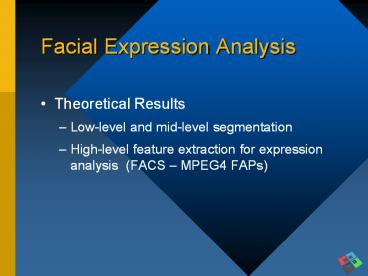Facial Expression Analysis - PowerPoint PPT Presentation
1 / 12
Title:
Facial Expression Analysis
Description:
Facial Expression Analysis. Theoretical Results. Low-level and mid-level segmentation ... Facial distances measured by US Army. 30 year period, Male/Female separation ... – PowerPoint PPT presentation
Number of Views:770
Avg rating:3.0/5.0
Title: Facial Expression Analysis
1
Facial Expression Analysis
- Theoretical Results
- Low-level and mid-level segmentation
- High-level feature extraction for expression
analysis (FACS MPEG4 FAPs)
2
Research Issues
- Which models/features (spatial /temporal)
- Which emotion representation
- Generalization over races / individuals
- Environment, context
- Multimodal, synchronization (hand gestures,
postures, visemes, pauses)
3
Emotion analysis system overview
G the value of a corresponding FAP
f Values derived from the calculated distances
4
Multiple cue Facial Feature boundary extraction
eyes mouth, eyebrows, nose
Edge-based mask Intensity-based mask NN-based
(Y,Cr,Cb, DCT coefficients of neighborhood)
mask Each mask is validated independently
5
Multiple cue feature extraction an example
6
Final mask validation through Anthropometry
Facial distances measured by US Army 30 year
period, Male/Female separation
The measured distances are normalized by division
with Distance 7, i.e. the distance between the
inner corners of left and right eye, both points
the human cannot move.
7
Detected Feature Points (FPs)
8
FAPs estimation
- Absence of clear quantitative definition of FAPs
- It is possible to model FAPs through FDP feature
points movement using distances s(x,y)
e.g. close_t_r_eyelid (F20) - close_b_r_eyelid
(F22) ? D13s (3.2,3.4) ? f13 D13 - D13-NEUTRAL
9
Sample Profiles of Anger
A1 F422, 124, F31-131, -25, F32-136,-34,
F33-189,-109, F34-183,-105, F35-101,-31,
F36-108,-32, F3729,85, F3827,89 A2
F19-330,-200, F20-335,-205, F21200,330,
F22205,335, F31-200,-80, F32-194,-74,
F33-190,-70, F34-190,-70 A3 F19
-330,-200, F20-335,-205, F21200,330,
F22205,335, F31-200,-80, F32-194,-74,
F3370,190, F3470,190
10
Problems
- Low-level segmentation
- environmental changes
- Illumination
- Pose
- capturing device characteristics
- noise
11
Problems
- Low-level to high level feature (FAP) generation
- Accuracy of estimation
- Validation of results
- Anthripometric/psychological constraints
- 3D information, analysis by synthesis
- Adaptation to context
12
Problems
- Statistical / rule-based recognition of high
level features - Definition of general rules
- Adaptation of rules to context/individuals
- Multimodal recognition dynamic analysis
- speech/face/gesture/biosignal/temporal
- Relation between modalities (significance,
attention, adaptation) - Neurofuzzy approaches
- Portability of systems to avatars/applications
(ontologies, languages)

